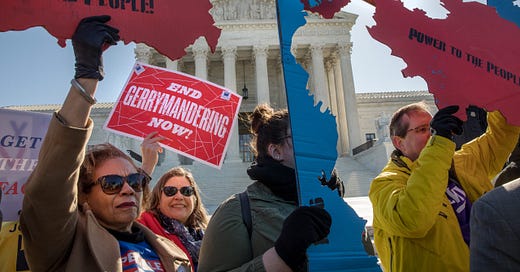
What Role Did Gerrymandering Play in Giving the GOP Its House Majority?
And how does it affect racial representation?
Though votes are still being counted in a few places, enough congressional races have been called to confirm that Republicans will take control of the House of Representatives in January. But the red wave that many predicted never materialized, and the Republicans are projected to have the narrowest majority in more than a century.
With a margin that slim, the true winner of the 2022 midterms may be the gerrymander.
In the wake of the 2020 census and two landmark voting rights Supreme Court cases—Shelby County v. Holder in 2013 and last year’s Brnovich v. Democratic National Committee—states were able to redraw congressional districts in ways that likely tilted the balance of power to Republicans in these midterms. Given the apparent partisan gerrymandering in places like Texas, Florida, and a few other Southern states, it’s estimated that Democrats lost electoral advantages in about 8 to 10 congressional districts. Additionally, New York Democrats’ inability to protect districts gerrymandered in their favor from a conservative state court also contributed to Republicans gaining 3 seats.
The balance of power in the House rests in these state decisions. As David Byler writes in the Washington Post, in an article arguing that the election results were “overdetermined,” Democrats are nonetheless “technically right to say the maps in Florida or New York pushed the GOP to victory.”
The present impact of gerrymandering was made possible by the recent weakening of the Voting Rights Act of 1965. The aforementioned cases effectively eliminated federal review of state redistricting for fairness and declared partisan gerrymandering a matter for voters (and not the courts) to address. Further, the Supreme Court declared last February that Alabama’s redistricting plan, which had been challenged as an unconstitutional racial gerrymander, could remain in place for this year’s elections. The justification for the decision was the Purcell principle, which holds that in the run-up to elections, courts should abstain from issuing rulings that would alter how those elections are conducted. The Supreme Court’s adherence to this guideline clearly indicates a winning, if unethical, loophole in election law: Draw your illegal districts close enough to an election, and the Court won’t interfere.
Among the many constitutional, legal, and fairness questions this raises, the centrality of black voters cannot be ignored. The issue at the heart of many redistricting disputes is whether majority and plurality black congressional districts should be advanced, protected, or dismantled.


Here’s the background: To ensure different racial groups have fair representation, those groups must be able to both participate in elections and have members of their groups elected to office. The Voting Rights Act codified this in law, outlawing discriminatory voting practices and giving states the ability to create majority-minority districts to increase the likelihood of minority representatives in legislatures. The Supreme Court then ruled that the intentional diluting of majority-minority districts—racial gerrymandering—is unconstitutional.
As these districts were created, the number of black members of the House of Representatives steadily increased, from 6 in 1967 to well over 50 in the current Congress. But two other factors came into play. The first is that black voters supported Democratic candidates by overwhelming margins, which continues today. The second is that legislators soon learned that by packing black voters into districts, it would both ensure black and Democratic victories there but also dilute their influence elsewhere. In this way, black voting power was both increased (insofar as more black representatives were in the halls of power) and decreased (by ensuring black voters were not the deciding electorate in more diverse and competitive districts).
For Republicans, if black voters can be packed into fewer districts or scattered across more districts, their likelihood of winning additional seats increases, as the recent midterms have shown. Given how evenly divided electoral politics is and the razor-thin margins in legislative bodies, state parties drawing themselves additional seats has significant ramifications. They not only shape state outcomes—as in Wisconsin, where Democrat Tony Evers won more than half the vote in the gubernatorial election, but Republicans will take two-thirds of the legislature and 6 of 8 congressional districts—but they can have cumulative effects that determine control of Congress.
Additionally, while diluting the black vote is unconstitutional, diluting a party’s hold on a district is not. But when the black vote is safely Democratic, what is the effective difference between racial and partisan gerrymandering? The answer is basically nothing. And soon, the distinction may not matter—the Supreme Court seems primed to make any challenges to racial gerrymandering incredibly difficult in this term’s Merrill v. Milligan.
What is certain is that the midterms have laid bare a series of consequential questions: Is it better to ensure black representatives in Congress through majority-minority districts, or create competitive districts where black voters are likely to be more consequential in the outcome? Should courts scrub the country of racial and partisan gerrymandering, or leave both to voters? And as more black representatives are winning districts that are not majority-minority, how does that change the nation’s understanding of the objectives of the Voting Rights Act?
Meanwhile, as these questions sit unresolved, the membership of Congress and many state legislatures is being settled in a way that reflects neither the expressed will of the people nor the fairness that the spirit of voting rights laws have long championed.











